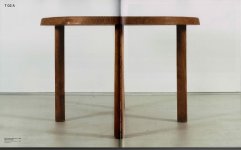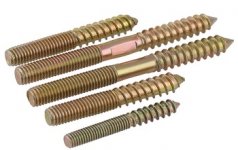ear3
Member
- Joined
- Jul 24, 2014
- Messages
- 4,341
I've accepted a commission to do a large elm table, recreating most of the design details of an original by a furniture designer from the 60s and 70s named Pierre Chapo:
[attachimg=1]
[attachimg=2]
The main difference in what I'm doing is in the size and shape of the 2" thick top. Instead of the original appx. 55" diameter circle, it will be half-trapezoidal (with two 90 degree corners), 60" long and the width at 30" and 39" respectively on either side. The legs will be 3" cylinders that are 27" long (so it's a bit shorter than your average dining table), and I will likely also turn another, shorter set of legs to allow them to do the coffee table thing.
The main challenge will be in securing the legs, which is what I'm asking about in this post. I've actually looked at examples of the original table in the flesh, and believe it or not they are connected with simple threaded inserts embedded in the underside of the top and bolts protruding from the top of the leg (they were approximately M10 size). There's a functional, modernist intent behind the original design, in that you can swap out for shorter legs to turn it from a dining table into a low coffee table.
That's a lot to ask from threaded inserts, especially given that the shape we are doing will place even more force on the legs when moving it from side to side than the original round design. I had asked whether they would be willing to consider mortise and tenon joinery for the legs, but they really want to stick to the original KD assembly design. There's some mitigation that can be done as far as embedding hidden, adjustable feet on the bottom of the legs that would have the dual function of leveling to uneven floors and being a furniture glide -- but still...
So I've been searching for more robust threaded inserts for wood, and the best I have found so far are the winged ones which allow you to secure them with screws:
https://www.rockler.com/screw-on-tee-nuts-choose-size-thread
But the max bolt size for those is 3/8 x 16. I'm looking for something that is more in the 1/2"-3/4" range, so that there's no danger of the bolt bending/flexing over the long term.
As far as I can tell, threaded inserts above 3/8" are for metal applications, like these acme keylock inserts:
http://www.acmeindustrial.com/keylockinsert.htm
These don't have the added security of the screws, but I could tap a hole in the table and epoxy the insert in there, and maybe jerry rig a thick fender washer with added countersunk holes that was inset flush with the table and screw it down for extra holding power.
Another option would be to mortise out a hole and epoxy in a coupling nut:
https://www.amazon.com/Hillman-Group-180225-Coupling-10-Inch/dp/B003VFXVMU/
But I would be worried about the long-term durability of the nut (even with a similar improvised screwed-down fender washer flange).
So, maybe someone knows about an option I haven't considered or have overlooked?
[attachimg=1]
[attachimg=2]
The main difference in what I'm doing is in the size and shape of the 2" thick top. Instead of the original appx. 55" diameter circle, it will be half-trapezoidal (with two 90 degree corners), 60" long and the width at 30" and 39" respectively on either side. The legs will be 3" cylinders that are 27" long (so it's a bit shorter than your average dining table), and I will likely also turn another, shorter set of legs to allow them to do the coffee table thing.
The main challenge will be in securing the legs, which is what I'm asking about in this post. I've actually looked at examples of the original table in the flesh, and believe it or not they are connected with simple threaded inserts embedded in the underside of the top and bolts protruding from the top of the leg (they were approximately M10 size). There's a functional, modernist intent behind the original design, in that you can swap out for shorter legs to turn it from a dining table into a low coffee table.
That's a lot to ask from threaded inserts, especially given that the shape we are doing will place even more force on the legs when moving it from side to side than the original round design. I had asked whether they would be willing to consider mortise and tenon joinery for the legs, but they really want to stick to the original KD assembly design. There's some mitigation that can be done as far as embedding hidden, adjustable feet on the bottom of the legs that would have the dual function of leveling to uneven floors and being a furniture glide -- but still...
So I've been searching for more robust threaded inserts for wood, and the best I have found so far are the winged ones which allow you to secure them with screws:
https://www.rockler.com/screw-on-tee-nuts-choose-size-thread
But the max bolt size for those is 3/8 x 16. I'm looking for something that is more in the 1/2"-3/4" range, so that there's no danger of the bolt bending/flexing over the long term.
As far as I can tell, threaded inserts above 3/8" are for metal applications, like these acme keylock inserts:
http://www.acmeindustrial.com/keylockinsert.htm
These don't have the added security of the screws, but I could tap a hole in the table and epoxy the insert in there, and maybe jerry rig a thick fender washer with added countersunk holes that was inset flush with the table and screw it down for extra holding power.
Another option would be to mortise out a hole and epoxy in a coupling nut:
https://www.amazon.com/Hillman-Group-180225-Coupling-10-Inch/dp/B003VFXVMU/
But I would be worried about the long-term durability of the nut (even with a similar improvised screwed-down fender washer flange).
So, maybe someone knows about an option I haven't considered or have overlooked?



